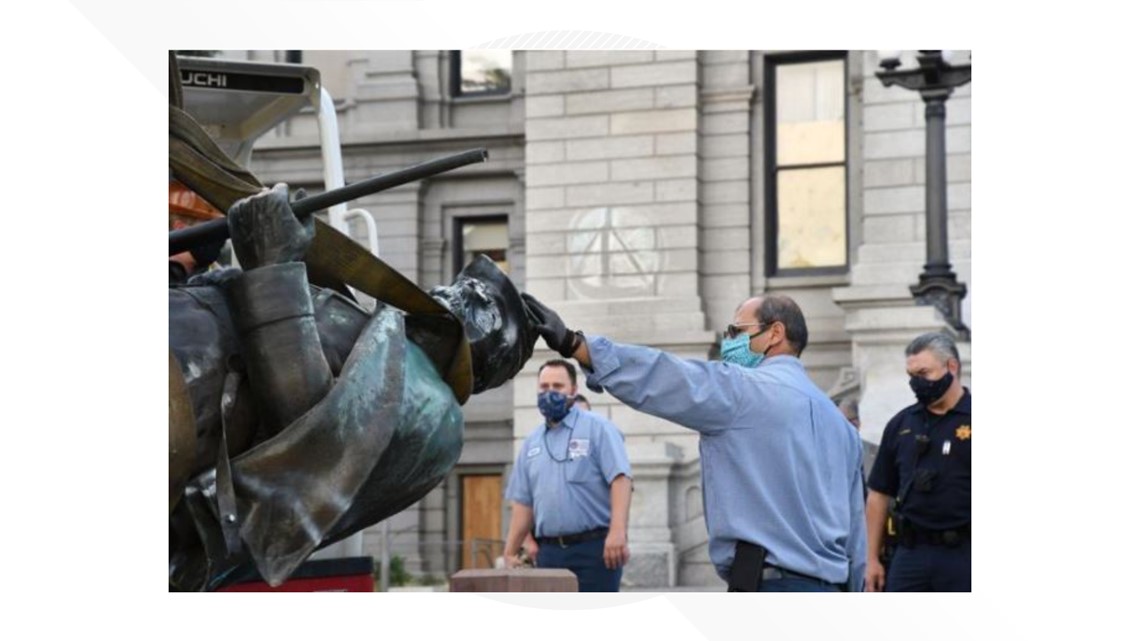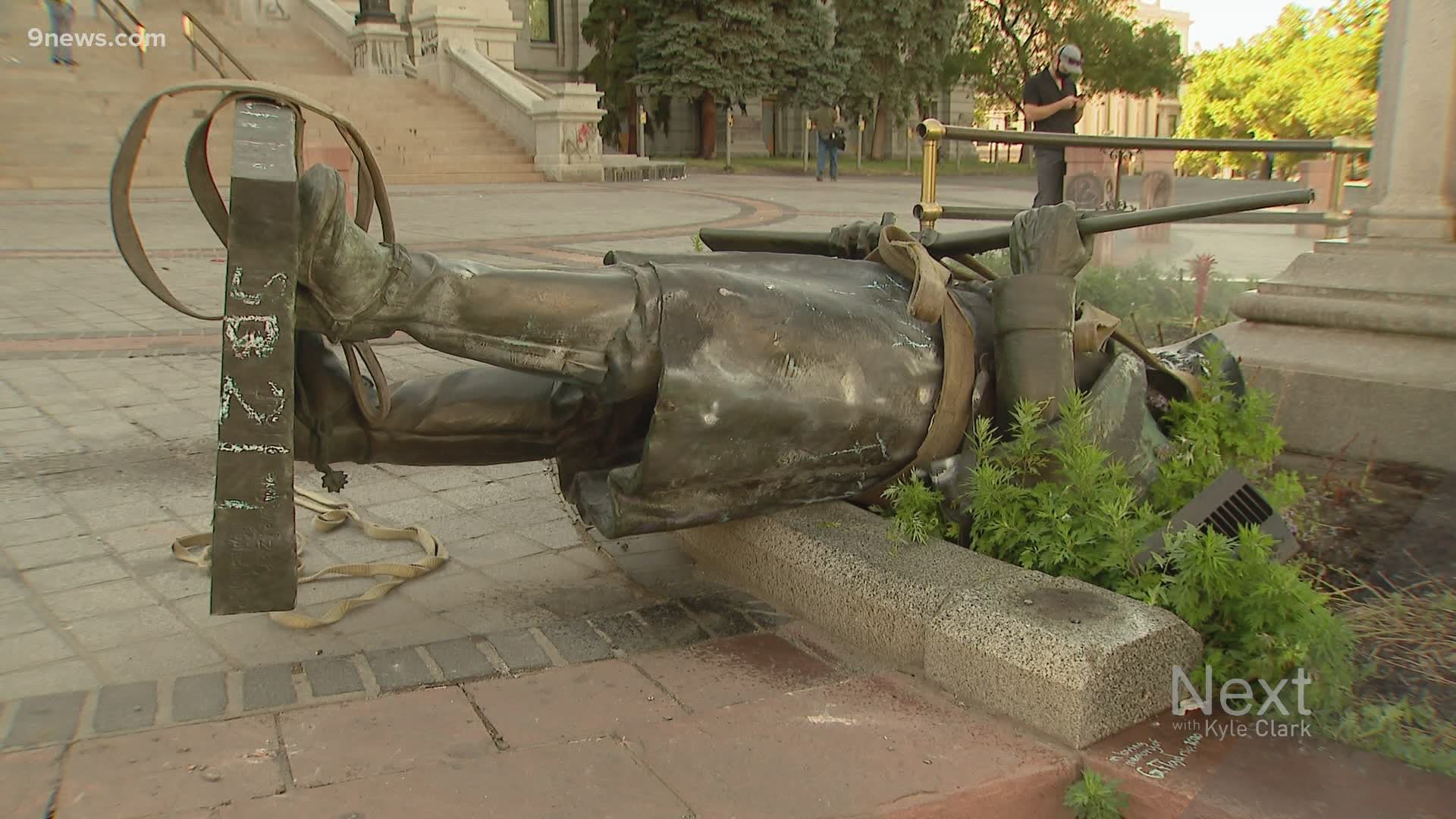DENVER — The statue that will serve as a memorial to the Sand Creek massacre is getting some pushback, not over the statue itself but about its proposed location.
That site — front and center on the state Capitol's west side — has garnered opposition from former Colorado Gov. Bill Owens and could be the subject of a ballot measure in 2022.
The Sand Creek statue, which was discussed last week by the Capitol Building Advisory Committee, would commemorate the 250 Cheyenne and Arapaho victims slaughtered in the Sand Creek massacre in Kiowa County in 1864. The proposed design, which is undergoing a few changes from artist Harvey Pratt, would be of a Native American woman in Cheyenne dress in mourning, an empty cradle in her right arm.
The site, as agreed to by Cheyenne and Arapaho representatives, is one that until last summer held a bronze statue of a Union soldier. That statue was torn down and damaged by vandals during the racial justice protests in June. The statue is now on loan to the History Colorado Center for the foreseeable future, complete with the graffiti it was tagged with.
> Above video: History Colorado offers to take the Civil War statue that was torn down during protests.
The issue with the statue last summer appeared to be its reference to Sand Creek as a Civil War battle. That’s from the statue’s origins in 1909. A plaque placed on the statue in 2002, during the Owens administration, noted that Sand Creek was not a Civil War battle.
But putting the Sand Creek statue in place of the Union soldier statue is what’s causing concern, in part the Capitol’s west side, which is the more public-facing side of the building, serves as a symbolic introduction to the Capitol.


Republican consultant Dick Wadhams, who was Owens’ spokesman, penned an op-ed for the Denver Post in December on the site issue.
Wadhams reiterated in an interview Monday with Colorado Politics that it's not the statue but the location .
"I really strongly feel that they’re rushing into this," Wadhams said. Even if the decision is made not to put the soldier back, there needs to be a thoughtful public conversation about the symbol that would be placed there, he explained. "It’s the only monument on the west side of the Capitol and it says a lot about our state and state Capitol.”
One comment Wadhams said he received after The Post op-ed ran was from someone who said putting the Sand Creek memorial on the site was akin to tearing down the Vietnam Veterans’ Memorial in Washington, D.C., and replacing it with a memorial to the victims of the My Lai massacre.
“I do not think the symbol of our state and our people is a massacre, and that’s what this would be transmitting,” Wadhams said Monday. “The monument should be on the Capitol grounds, but it should not define our state by being in that spot.”
Owens agrees with Wadhams' perspective. The former governor told Colorado Politics on Monday that he favors a more all-encompassing memorial to Coloradans who have served in the military on that site.
He also pointed to what happened in Washington, D.C., on Jan. 6. When the U.S. Capitol was attacked, the building was restored, Owens said.
“We don’t let rioters choose to make public policy,” he said.
Owens said four rioters tore down the Union soldier statue last summer, and he said that vandalism should not be allowed to stand.
“We should put the statue back, with a broader purpose,” Owens said. He suggests putting the original statue back in place, and redesigning the plaques that surround the base, in order to honor all veterans and to remove the reference to Sand Creek.
Rep. Susan Lontine, D-Denver, who chairs the Capitol Building Advisory Committee, said she's heard about concerns for the site. But veterans organizations have not been able to agree on where the Union soldier statue should go. Lontine said the Department of Military Affairs would like to place it in front of their building.
That may not be the last word on the issue. Owens said he is aware of discussions around a ballot measure for 2022 that would propose putting the original statue back on its original site.
The site for the Sand Creek memorial has been among the memorial's most difficult decisions. In 2017, it won approval from the General Assembly and then-Gov. John Hickenlooper, but the issue of where the statue would go was never resolved.
A lack of agreement persisted between the state and among the Native American tribes – the Northern Cheyenne, Northern Arapaho, and the Southern Cheyenne and Arapaho — about where the statue would go. One proposal would place it on the southeastern corner of the Capitol grounds, near the intersection of 14th Avenue and Grant Street, and another offered a site near the other Native American statue known as “Closing Era.” Still another proposed location was on the Capitol’s west side, near the Union soldier statue, a location that the state didn't approve.
The Capital Development Committee is scheduled to review the site selection Wednesday morning.
Kathryn Redhorse, executive director of the Colorado Commission on Indian Affairs, who has been working with the Native tribes on the statue, was not immediately available for comment.
SUGGESTED VIDEOS: Colorado’s History

